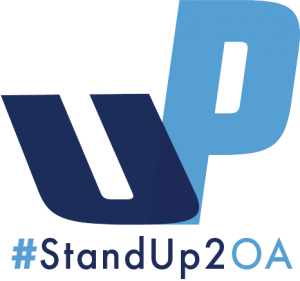StandUp2OA
Join us and together, we can prevent osteoarthritis

Today, 32.5 million people – 1 in almost every 7 American adults – have osteoarthritis (OA). This disease mainly affects the hands, knees, and hips in adults. OA rates are expected to increase in the years ahead as Baby Boomers age and the effects of the obesity epidemic begin to manifest. Osteoarthritis is common, costly and a leading cause of disability.
But there’s cause for hope, OA can be prevented. Here’s how.
How can I prevent OA?
Preventing injuries, moving more, and managing your weight are the primary ways you can lower your risk of developing OA. They’re also a great way to feel better in your day-to-day!
Stop OA in its tracks by incorporating these activities into your life.
Injury Prevention
Train your muscles now to limit injury later. Knee and other joint injuries often lead to OA, but they can be avoided.
Simple exercises you can do at home can reduce your risk of knee injuries by up to 80%.
Explore our recommended exercises here.
Weight Management
Maintaining a healthy weight can also help prevent OA.
Our knees and other joints get more sensitive as we age. Weight management, through a healthy diet and exercise, can limit the pain of strained joints and tissue.
Read our tips for weight management here.
Learn more about prevention and management strategies in our resource library and in the OA Action Blog.
Want more information sent directly to your inbox?
Subscribe to our StandUp2OA newsletter to get 6 months of easy tips to help you prevent osteoarthritis and help spread the message of prevention!
How You Can StandUp2OA
Chances are, you or someone in your life or community is at risk of OA. We have resources that can help.

|
If your joints are healthy and pain-free, or you are at risk and want to prevent OA, see your care provider for ideas on reducing your risk. Risk reduction strategies include preventing joint injury and maintaining a healthy weight. Learn more about these strategies.
|
 |
If you have or think you have OA, see your care provider for ideas on reducing the impact of OA or joint pain on your everyday life, including managing your symptoms such as pain, stiffness, and swelling; improving joint mobility and flexibility; maintaining a healthy weight; and getting regular physical activity. Learn more about living an active life with OA.
|
If you’re a health care provider, help your OA patients by encouraging physical activity, weight management, and referring them to arthritis-appropriate proven interventions, and community- based programs. Get more ideas here.
|
|
If your organization is involved in OA education and prevention, become a partner with OAAA and help share information about effective community interventions—and then support those efforts among your group’s members. Download resources here.
|
|
If you’re a policymaker, help OAAA make osteoarthritis a public health priority through policy decisions and solutions, and funding allocations. Addressing OA makes whole communities healthier. Check out community health solutions here.
|
Help Us StandUp2OA by spreading the message
Use the hashtag #StandUp2OA to share and promote evidence-based public health intervention activities that can help prevent and manage #osteoarthritis.
Follow us on Facebook, Twitter, LinkedIn, and Instagram to stay up-to-date on the latest news and connect with other advocates.
Spread the Message of #StandUp2OA with easy to share messages.
Download the Interactive Campaign Toolkit [Printer-friendly toolkit]
Subscribe to our StandUp2OA newsletter to get 6 months of easy tips to help you prevent osteoarthritis and help spread the message of prevention!
